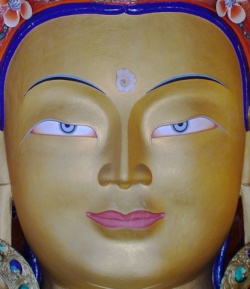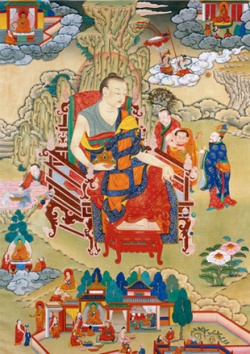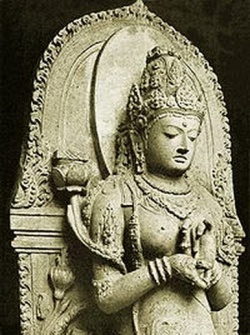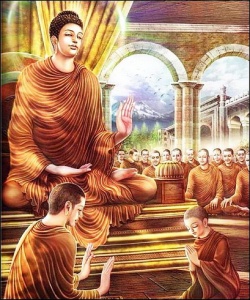Jātakas
The Jātakas (Sanskrit जातक) (also known in other languages as: Burmese: ဇာတ်တော်, pronounced: [zaʔ tɔ̀]; Khmer: ជាតក cietɑk; Lao: ຊາດົກ sadok; Thai: ชาดก chadok) refer to a voluminous Body of literature native to India concerning the previous births (Jāti) of the Bodhisattva.
These are the stories that tell about the previous lives of The Buddha, in both human and animal Form.
The future Buddha may appear in them as a king, an outcast, a God, an elephant—but, in whatever Form, he exhibits some Virtue that the tale thereby inculcates.
In Theravada Buddhism, the Jatakas are a textual division of the Pali Canon, included in the Khuddaka Nikaya of the Sutta Pitaka. The term Jataka may also refer to a traditional commentary on this book.
History
The Jatakas were originally amongst the earliest Buddhist literature, with metrical analysis methods dating their average contents to around the 4th century BCE.
The Mahāsāṃghika Caitika sects from the Āndhra region took the Jatakas as canonical literature, and are known to have rejected some of the Theravada Jatakas which dated past the time of King Ashoka.
The Caitikas claimed that their own Jatakas represented the original collection before the Buddhist tradition split into various lineages.
According to A.K. Warder, the Jatakas are the precursors to the various legendary biographies of The Buddha, which were composed at later dates.
Although many Jatakas were written from an early period, which describe previous lives of The Buddha, very little biographical material about Gautama's own Life has been recorded.
Contents
The Theravada Jatakas comprise 547 poems, arranged roughly by increasing number of verses. According to Professor von Hinüber,[7] only the last 50 were intended to be intelligible by themselves, without commentary.
The commentary gives stories in prose that it claims provide the context for the verses, and it is these stories that are of Interest to folklorists.
Alternative versions of some of the stories can be found in another book of the Pali Canon, the Cariyapitaka, and a number of individual stories can be found scattered around other Books of the Canon.
Many of the stories and motifs found in the Jataka such as the Rabbit in the Moon of the Śaśajâtaka (Jataka Tales: no.316), are found in numerous other languages and media.
For example, The Monkey and the Crocodile, The Turtle Who Couldn't Stop Talking and The Crab and the Crane that are listed below also famously feature in the Hindu Panchatantra, the Sanskrit niti-shastra that ubiquitously influenced World literature.
Many of the stories and motifs being translations from the Pali but others are instead derived from vernacular oral traditions prior to the Pali compositions.
Sanskrit (see for example the Jatakamala) and Tibetan Jataka stories tend to maintain the Buddhist Morality of their Pali equivalents, but re-tellings of the stories in Persian and other languages sometimes contain significant amendments to suit their respective cultures.[citation needed]
Apocrypha
Within the Pali tradition, there are also many apocryphal Jatakas of later composition (some dated even to the 19th century) but these are treated as a separate category of literature from the "Official" Jataka stories that have been more-or-less formally canonized from at least the 5th century — as attested to in ample epigraphic and archaeological evidence, such as extant illustrations in bas relief from ancient temple walls.
Apocryphal Jatakas of the Pali Buddhist Canon, such as those belonging to the Paññā sajātaka collection, have been adapted to fit local culture in certain South East Asian countries and have been retold with amendments to the plots to better reflect Buddhist morals.
Celebrations and ceremonies
In Theravada countries several of the longer Jatakas such as Rathasena Jataka and Vessantara Jataka, are still performed in dance, theater, and formal (quasi-Ritual) recitation.[15] Such celebrations are associated with particular holidays on the lunar Calendar used by Cambodia, Thailand and Laos.
Translations
The standard Pali collection of Jatakas, with canonical text embedded, has been translated by E. B. Cowell and others, originally published in six volumes by Cambridge University Press, 1895-1907; reprinted in three volumes, Pali Text Society,[16] Bristol. There are also numerous translations of selections and individual stories from various languages.
Jacobs, Joseph (1888), The earliest English version of the Fables of Bidpai, London Google Books (edited and induced from The Moral Philosophie of Doni by Sir Thomas North, 1570)
List of Jatakas
This list includes stories based on the Jatakas:
Grannie's Blackie
How the Turtle Saved His Own Life
Prince Sattva
Sibi Jataka
The Ass and the Pig
The Ass in The lion's Skin
The Banyan Deer
The Crab and the Crane
The Elephant Girly-Face
The Foolish, Timid Rabbit
The Great Ape
The King's White Elephant
The lion, the Bear and the Fox
The Measure of Rice
The Merchant of Seri
The Monkey and the Crocodile
The Ox Who Envied the Pig
The Ox Who Won the Forfeit
The Princes and the Water-Sprite
The Quarrel of the Quails
The Sandy Road
The Tiger, the Brahmin and the Jackal
The Tortoise and the Birds
The Turtle Who Couldn't Stop Talking
The Twelve Sisters
The Wise and the Foolish Merchant
Vessantara Jataka
Why the Owl Is Not King of the Birds



